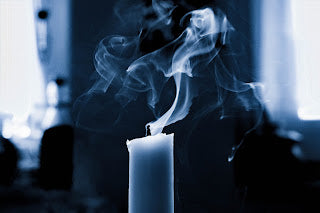
What is the best way to extinguish a candle?
Share
 |
| Candle that is smoking after being blown out |
Blowing a candle out may be quick but it will also increase indoor air pollution and soot on walls and ceilings. Soot is the black waxy residue that you often see on candle jars. The excess smoke that is given off is actually incomplete burned candle. When you blow out a candle the wick will often still glow red and incomplete combustion will occur which results in the smoke and soot. Snuffing will also result in a lot of smoke being released as the wick struggles for air. When you lift the snuffer you are also be releasing smoke and soot into the air. Smoke particles can also be breathed in before they are deposited on your living space. And that may not be the healthiest option.
 |
| Candle wick dipper being used to extinguish a flame |
When dipping your wick into your wax be sure to use a non-flammable object such as a metal dipping stick or even a piece of coat hanger so that it doesn't catch on fire.
Remember - Don't blow it. Dip it :)
Till next time!
